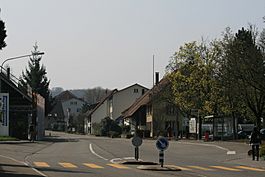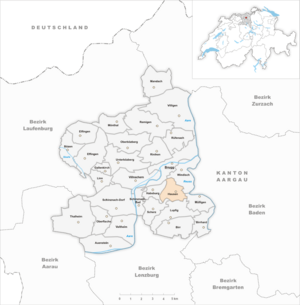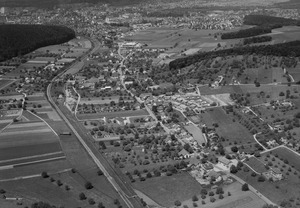Hausen AG facts for kids
Quick facts for kids
Hausen bei Brugg
|
||
|---|---|---|
 |
||
|
||
| Country | Switzerland | |
| Canton | Aargau | |
| District | Brugg | |
| Area | ||
| • Total | 3.2 km2 (1.2 sq mi) | |
| Elevation | 380 m (1,250 ft) | |
| Population
(Dec 2020 )
|
||
| • Total | 3,734 | |
| • Density | 1,167/km2 (3,020/sq mi) | |
| Postal code |
5212
|
|
| Surrounded by | Brugg, Habsburg, Lupfig, Mülligen, Scherz, Windisch | |
| Twin towns | Hausen im Wiesental (Germany) | |
Hausen (which was called Hausen bei Brugg before 2003) is a town in Switzerland. It is located in the Aargau canton, within the Brugg district. This area is known for its beautiful Swiss landscapes.
Contents
History of Hausen
Ancient Times and Roman Era
The area around Hausen has a very long history. Archaeologists have found graves from the Iron Age here. This shows that people lived in this region thousands of years ago.
Later, a Roman town was built where Hausen is today. You can still see parts of Roman buildings, roads, and even water pipes. One of these ancient water pipes is still used today!
First Mention and Early Ownership
The modern village of Hausen was first written about in the year 1254. It was called Husen back then. Hausen was once part of the original lands owned by the famous Habsburg family.
Religious Changes
For a long time, Hausen was part of the church parish in Windisch. But in 1978, the people of Hausen built their own Reformed church. This was an important step for the community.
Economy Through the Ages
In the past, farming was the main way people made a living in Hausen. Growing grapes for vineyards was especially important. Since the 1700s, making textiles (like cloth) also became a big part of the local economy.
During the Middle Ages, people dug for limestone in Hausen. In the late 1800s, they also mined clay.
Modern Development and Growth
A bus service started in Hausen in 1955, making it easier for people to travel. After 1950, many new homes were built, and the town's population grew a lot. As more people moved in, the town improved its services and facilities.
Geography of Hausen
Hausen covers an area of about 3.21 square kilometers (1.24 square miles). A large part of this land is covered by forests, making up about 47.4% of the area. About 21.8% of the land is used for farming.
The town itself, with its buildings and roads, takes up about 29.6% of the land. There are also small rivers and streams that flow through the area. Hausen is known for being a "linear village," meaning it grew along a main road or river.
Coat of Arms
The coat of arms for Hausen is quite interesting. It shows a silver house with a red roof on a green base, all on a blue background. This design is a type of "canting" symbol. This means the picture on the shield sounds like the name of the place. In German, the word for "house" is Hausen, which is the same as the town's name!
Population and People
Hausen has a population of about 3,800 people. Many different people live here. About 20% of the people living in Hausen are from other countries.
Most people in Hausen speak German, which is the main language. Italian is the second most common language, and Albanian is the third.
Education in Hausen
The people in Switzerland are generally well-educated. In Hausen, about 75% of adults (aged 25–64) have finished high school or gone on to higher education, like university. In the 2008/2009 school year, there were over 200 students attending primary school in Hausen.
Economy and Jobs
In 2007, the unemployment rate in Hausen was quite low, at about 2.1%. This means most people who wanted to work had jobs.
Types of Jobs
- Primary Sector: A small number of people work in farming.
- Secondary Sector: About 138 people work in industries like manufacturing.
- Tertiary Sector: The largest number of jobs, around 913, are in the service industry. This includes jobs in shops, offices, and other services.
Many people who live in Hausen travel outside the town for work. However, many people also come into Hausen to work. About 18.6% of workers use public transportation, like buses, to get to their jobs. More than half, about 51.2%, use their own cars.
Religion
According to a census from 2000, about 36.7% of the people in Hausen were Roman Catholic. A slightly larger group, about 42.5%, belonged to the Swiss Reformed Church. There were also a few people who were part of the Christian Catholic faith.
See also
In Spanish: Hausen (Suiza) para niños






